
Recently on Cyclingnews.com |
On test: DeRosa Avant, September 25, 2006
De Rosa Avant
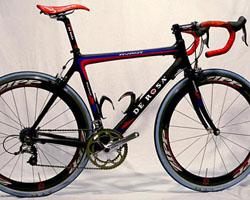
|
Last year, Cyclingnews' Mark Zalewski test rode a curvy carbon frame from De Rosa called the Tango. And while the review was positive, Zalewski was critical about the carbon fibre frame's weight (1.75kg). Well, Ugo De Rosa must have listened, because for 2006 they are offering the Avant -- a straight-tubed, no-nonsense brother of the Tango that shaves weight but doesn;t comprimise its stiffness. U.S. importer Albabici set us up with a test ride complete with the new SRAM Force road group from their neutral service fleet.
When I found out that I was going to have an opportunity to test ride another De Rosa, my first thought was of the Tango I rode last year. It was an impressive ride for sure, with its best quality being the stiffness. But the stiffness came at a price in terms of weight. So I wondered which would be sacrificed in this new incarnation. Much to my enjoyment, neither.
But first, lets talk carbon. The Avant has a similar look to the Tango in terms of colour scheme (but sans the wavy tubing). The paint is minimal and is there mostly as an accent for the naked carbon 3K weave, which produces that nicely aligned checkerboard look. Still, three paint choices are available, the Blu Line, Red Line and the Lapis, which is a combination of the other two and was the color scheme of the test bike.
Looking closer at the frame attributes, the Avant is a rather simple monobloc design that does not use any unnecassary carbon. This is evident when doing a side-by-side comparison with the Tango as the seat and chain stays are minimal while the connection points, like the bottom bracket area and head tube, are beefed up to maintain the appropriate stiffness. But a similarity is the use of a sloping design for the top tube, creating a nice solid and symmetrical union with the seat tube and seat stay. Keeping the light trend, De Rosa shipped a mizuno full carbon fork and carbon seat post with the frame.
In terms of all carbon bikes, the Avant is not the lightest by any means, or close to the infamous sub-1 kilo mark. The frame, fork and headset that come together total 1.6 kilos. But our test bike, with the additions described below weighed a lovely 7.59 kilos -- plenty light for my tastes.
Our test bike was sent with carbon bits and add-ons where ever possible -- including the Deda Ultra Carbon stem and Deda Glare carbon handlebars. However, when I first looked at the handlebars with their flat top profile, I turned up my nose -- having had too many bad experiences with
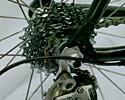
|
this type of bar. But then again, looking at the simplistic beauty of the carbon construction, I decided to reserve judgement until at least after the maiden ride. Oh, and what carbon road warrior would dare use a non-carbon bottle cage! Not this tester, who was given two Elite carbon cages.
Lucky for me, De Rosa's U.S. importer Albabici was able to hook up with the people at SRAM to outfit our test bike with SRAM's Force group and Zipp 404 wheels from their neutral service crew, giving us an extra incentive to ride this beautiful machine. While I will include some remarks about riding the Force group below, this was still a prototype set. But, look for our full no-holds-barred review from James Huang soon on Cyclingnews!
As long as I am listing initial reactions to this bike, I should probably mention my first impression of the saddle. When the bike was first hoisted down from the SRAM car I thought the mechanic, Jose Acala, was just playing a joke on me. The SMP Evolution Strike saddle, in blazing red, was hard not to notice. However, the colour did not grab my attention as much as the design. Yikes! Excuse me, but is this a medieval torture device? After checking my calendar to make sure it was not April 1, Jose assured me that this new design was winning early praise and that I should not be such wuss. So again, I reserved judgement.
Gimmie, gimmie gimmie!
'Yeah, yeah Jose, I can figure out this new SRAM shifting -- Leapfrog this with a Doubletap there... just let me ride it!' Getting out on the road with this bike was always going to be an experience, so I decided to show off my new ride to a large audience -- the lakefront path along downtown Chicago. Not so often do I ride with deep rim wheels like the 404s, so the wind off of Lake Michigan made this ride a little extra challenging, but not nearly as much as every third person asking me something about this bike. It clearly stood head and shoulders above the rest and everyone knew it.
With that parade ride complete I took to the real roads where I could put this lighter carbon frame to a stiff test (pun intended). De Rosa promises that the new design will be lightweight and reactive -- yes and yes. The designers clearly made a point of not including any unnecessary carbon on the frame, leaving a truly responsive ride that feels much lighter.
Jumping out of the saddle on flats or exiting turns resulted in no noticeable flex in the bottom bracket. On the contrary, I felt like I was trying to keep up with a bike that wanted to go faster! Going up hill, the lightness of the frame was much welcomed and on the other side I was encouraged with a very stable ride, even with slapping the top tube to check for excessive play.

|
Cornering through the pack in crits was without hesitation, aided by the nice Michelin service courses tyres wrapped around the 404s. But the fork and frame geometry really gave a nimble agility to the bike. Turning attention to the longer rides, the Avant absorbed most of the bumps and knocks thrown at it pretty well, which is something I thought might be lacking compared to the Tango's higher weight. But really long rides did take a toll on me.
The Force group is best described as a breath of fresh air. My previous limited looks at the group only partially prepared me for this longer use. I really have nothing critical to say about the group in terms of ride-ability. The shifting was clean and crisp, with nary a miss or half-shift. And I enjoyed only having to use one lever for all of my shifting needs. Converting to this new style was not hard at all. In fact, going back to other shifting has proven to be more of a challenge!
The best thing I can say about this group is the attention given to the ergonomics. I never had a hotspot while riding any portion of the levers. Further, everything is in the right place, giving your hands many options. Though our resident enginerd has yet to offer his opinion, my initial experience is two thumbs way up.
Two strikes
I know it seems that the saddle and handlebars entered this phase with two strikes against them (and not just in the name of the saddle.) But this fact should only strengthen their credibility after I finish telling you how much I enjoyed each of them.
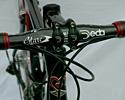
|
First the handlebars. My previous experiences with handlebars that have a flattened top bar have not been good. My findings have been that this limits the positions I can have on top, which is not good when I spend around half of my time there. Too often I will get cramps in my wrist from being in the same position too long, due to the fact that it is the only position. But these Deda Glare bars have won me over by offering a compromise of sorts. The tops of these bars are not nearly as wide as others, allowing for more positions while still giving a larger surface area. Bravo!
The comment I got most about this bike was this. 'That has GOT to hurt!' referring to the saddle missing half of the saddle! And my response? 'Not at all! Actually, it feels so much better than my old saddle.' The missing part is missing for a reason -- you do not need it. By removing this part of the saddle, there is reduced chance that pressure points will cause discomfort. This was most evident when I traveled to Boulder and borrowed a friend's bike for a ride. The conventional saddle gave me numbness after only an hour of riding, so I was quite happy to return home to this saddle.
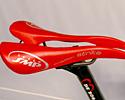
|
My only gripe about this bike comes just below the saddle. The De Rosa seatpost and I did not get along well at all. My first bad encounter was about three weeks into the review. After adjusting the seat height, I had ridden it often without any problems. But of course, the first race I enter with this jaw-dropping steed, the seat post decides to slip to the point that the handlebars were suddenly even with my shoulders. And of course this was a road race without any free laps. This did allow me to do my best impression of a Euro-pro hanging on to the neutral support car accelerating to 40 mph with a mechanic leaning out of the window trying to bring the seat up. But even after tightening the clamp well beyond a reasonable tourque, the post continued to slip.
Ok, so this is nothing a little friction compound cannot fix. True. My real problem is with the seat post clamp. Good intentions but just not a good design. It is a two bolt clamp with the intent to have a way to make slight adjustments to the angle of the seat by making small turns to the front bolt. However, I was on the bad end of this design in another race when the bolts came loose and my seat decided to just fall off! Let me tell you, this is one way to make your fellow racers nervous.
This problem was exacerbated by the fact that the two bolt design has two different bolts -- one requiring an hex wrench and the other requiring a small crescent-style wrench for the micro adjustments. This made it extremely difficult to put the seat back on, let alone in the heat of the racing moment. Additionally, tightening the micro-adjustment bolt is a nuisance.
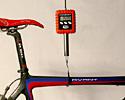
|
Conclusion
Other than this small problem, which can be easily remedied, the bike performed as expected. Now this is where the usual bad news comes in, the price. And at $2,200USD for the frame and fork it certainly is not a bottom-shelf bargain. However, in comparison to the rest of the De Rosa line it is the cheapest carbon option available and a nice ride to be sure. From there, it is up to you to dress it up or down fitting your taste and budget.
Suggested retail prices: USA: US$2,200, frame and fork only
Weight: 1.6 kg (frame & fork), 7.59 kg (as tested)
Pro: light and stiff, good bike for the money
Con: Seat post clamp and long ride comfort
Cyclingnews Rating: ![]()
Photography
For a thumbnail gallery of these images, click here
Images by Mark Zalewski/Cyclingnews.com
- De Rosa's Avant in its Lapis colour scheme
- Michelin tyres compliment the bike's nimble agility
- The Force group gearing is clean and crisp
- The bike features SRAM Force carbon fibre cranks
- Deda's all carbon handlebars receive two thumbs up
- Deda Glare carbon handlebars are an optional extra
- The Avant features a Mizuno fork with 1-1/8inch headset
- Strengthening around the connection point areas provides the frame with appropriate stiffness
- The carbon frame, fork and headset weights 1.6kilos
- The test bike weighed in at a reasonable 7.59kilos
- Among the bike's optional extras is two carbon fibre bottle cages
- The Avant uses minimal paint in its colour schemes allowing the fibre pattern to show through
- While an easy problem to rectify the seatpost does have a tendency to slip
- While it may be lighter the Avant retains all of the Tango's stiffness
- Havoc causer: the seatpost clamp's adjustability works in theory, just not in practice
- Take a really long ride on the Avant and your rear will pay the price
- Looks painful- but the Avant proves looks can be deceiving – at least on short to medium rides
Full specification: De Rosa Avant Frame: Avant Cranks: SRAM Force |
Wheels: Zipp 404 Stem: Deda Ultra Carbon Pedals: N/A More information: www.derosanews.com |

